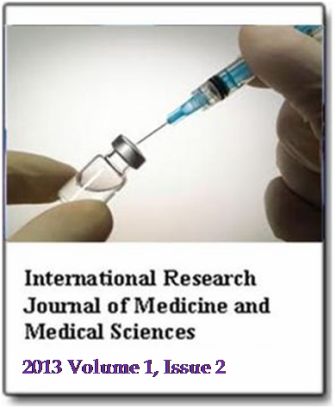Seroconversion of anti-HBs alone among certain high risk groups in Al-Ramadi City, Western Iraq
Hammodi F. Al-jumaily, Attalla M. Turky and Mohammed S. DawoodInternational Research Journal of Medicine and Medical Sciences
Published: April 15 2013
Volume 1, Issue 2
Pages 56-63
Abstract
Hepatitis B causes significant morbidity and mortality worldwide. Little is known about the existence of hepatitis B among high risk groups of the Ramadi population and the prevalence of anti-HBs alone or in combination with other markers. The present study was conducted to determine the magnitude of anti-HBs alone (a serologically confirmed past vaccination) in certain high risk groups, their comparison and its relation to age and other factors associated with serological marker positivity. This cross sectional study was carried out in Al-Ramadi city, Al-Anbar province, western Iraq, from January 2011 to July 2012. A screening of anti-HBs was performed on blood samples that were collected from five vulnerable or risky groups including hemodialysis patients, barbers, family contacts to a known hepatitis B patient, cuppers and health care workers (HCWs). Demographic information was recorded and the vaccination status was assessed by detailed interview. Analysis was conducted using the Epi info 7 software. A total of 789 subjects were screened. Of these, 294 individuals were reactive with anti-HBs alone. Most of the studied groups showed higher rate of findings with high significant statistically. In concern to age, being ≤ 19 years old age showed the highest rate (45.5) for testing positive for anti-HBs alone. Other age groups were of lower rates ranging from (25.4 to 40.1%). Males showed higher rate (38.7%) of positivity in contrast to females (33.8%). However, positive past history of jaundice showed lower rate (15.1%) than negative history (40.9%), regarding anti-HBs positive (alone) with high significance (p < 0.001). The vaccinated group showed the highest positivity for anti-HBs (alone) (55.8%) and the difference was statistically high significance (p < 0.001). Also, unknown history regarding vaccination status showed lower rate (31.1%) with statistical high significance (p < 0.001). For number of vaccine versus seropositivity of anti-HBs alone, highest rate (65.03%) was apparently among those with 3 doses followed by those with 2 doses and 1 dose (60 and 15.2%, respectively) with statistically significant (p value < 0.001). In concern to the duration of last dose effect on seropositivity of anti-HBs alone, those of last dose duration between 1 and 5 years showed the highest rate (57.89%), while those of less than one year duration was slightly lower (56.89%). On the other hand, those with more than 5 years duration were of rate (39.02%) and the difference was statistically significant (p = 0.03). The importance of the control of chronic hepatitis B in certain high risk groups was highlighted by this study, as these pools provide a trigger for the spread of disease in the community. Family contacts and HCWs showed the higher rate of anti-HBs positivity. Males were more affected than females with predominance of ≤ 19 years old age. Moreover, vaccinated group showed the significantly highest rate, particularly among those who received the 3rd dose of vaccine.
Keywords: Anti-HBs alone, hepatitis B, high risk groups, Ramadi City.
Full Text PDF
